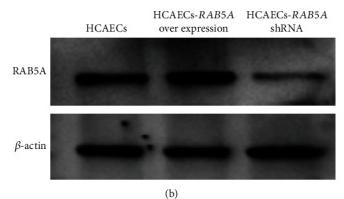Rab5A Antibody - #DF6314
| Product: | Rab5A Antibody |
| Catalog: | DF6314 |
| Description: | Rabbit polyclonal antibody to Rab5A |
| Application: | WB IHC |
| Cited expt.: | WB |
| Reactivity: | Human, Mouse, Rat |
| Prediction: | Bovine, Horse, Rabbit, Dog, Chicken |
| Mol.Wt.: | 24kDa; 24kD(Calculated). |
| Uniprot: | P20339 |
| RRID: | AB_2838280 |
Product Info
*The optimal dilutions should be determined by the end user. For optimal experimental results, antibody reuse is not recommended.
*Tips:
WB: For western blot detection of denatured protein samples. IHC: For immunohistochemical detection of paraffin sections (IHC-p) or frozen sections (IHC-f) of tissue samples. IF/ICC: For immunofluorescence detection of cell samples. ELISA(peptide): For ELISA detection of antigenic peptide.
Cite Format: Affinity Biosciences Cat# DF6314, RRID:AB_2838280.
Fold/Unfold
RAB 5; RAB 5A; RAB5A; RAB5A member RAS oncogene family; RAB5A_HUMAN; RAS associated protein RAB5A; Ras related protein Rab 5A; Ras-related protein Rab-5A;
Immunogens
A synthesized peptide derived from human Rab5A, corresponding to a region within C-terminal amino acids.
- P20339 RAB5A_HUMAN:
- Protein BLAST With
- NCBI/
- ExPASy/
- Uniprot
MASRGATRPNGPNTGNKICQFKLVLLGESAVGKSSLVLRFVKGQFHEFQESTIGAAFLTQTVCLDDTTVKFEIWDTAGQERYHSLAPMYYRGAQAAIVVYDITNEESFARAKNWVKELQRQASPNIVIALSGNKADLANKRAVDFQEAQSYADDNSLLFMETSAKTSMNVNEIFMAIAKKLPKNEPQNPGANSARGRGVDLTEPTQPTRNQCCSN
Predictions
Score>80(red) has high confidence and is suggested to be used for WB detection. *The prediction model is mainly based on the alignment of immunogen sequences, the results are for reference only, not as the basis of quality assurance.
High(score>80) Medium(80>score>50) Low(score<50) No confidence
Research Backgrounds
Small GTPase which cycles between active GTP-bound and inactive GDP-bound states. In its active state, binds to a variety of effector proteins to regulate cellular responses such as of intracellular membrane trafficking, from the formation of transport vesicles to their fusion with membranes. Active GTP-bound form is able to recruit to membranes different sets of downstream effectors directly responsible for vesicle formation, movement, tethering and fusion. RAB5A is required for the fusion of plasma membranes and early endosomes. Contributes to the regulation of filopodia extension. Required for the exosomal release of SDCBP, CD63, PDCD6IP and syndecan. Regulates maturation of apoptotic cell-containing phagosomes, probably downstream of DYN2 and PIK3C3 (By similarity).
Phosphorylation of Ser-84 in the switch II region by LRRK2 prevents the association of RAB regulatory proteins, including RAB GDP dissociation inhibitors GDI1 and GDI2.
Cell membrane>Lipid-anchor>Cytoplasmic side. Early endosome membrane>Lipid-anchor. Melanosome. Cytoplasmic vesicle. Cell projection>Ruffle. Membrane. Cytoplasm>Cytosol. Cytoplasmic vesicle>Phagosome membrane. Endosome membrane.
Note: Enriched in stage I melanosomes (PubMed:17081065). Alternates between membrane-bound and cytosolic forms (Probable).
Belongs to the small GTPase superfamily. Rab family.
Research Fields
· Cellular Processes > Transport and catabolism > Endocytosis. (View pathway)
· Cellular Processes > Transport and catabolism > Phagosome. (View pathway)
· Environmental Information Processing > Signal transduction > Ras signaling pathway. (View pathway)
· Human Diseases > Neurodegenerative diseases > Amyotrophic lateral sclerosis (ALS).
· Human Diseases > Infectious diseases: Parasitic > Amoebiasis.
· Human Diseases > Infectious diseases: Bacterial > Tuberculosis.
· Organismal Systems > Excretory system > Vasopressin-regulated water reabsorption.
References
Application: WB Species: Human Sample: HCAECs
Application: IF/ICC Species: Human Sample: HCAECs
Restrictive clause
Affinity Biosciences tests all products strictly. Citations are provided as a resource for additional applications that have not been validated by Affinity Biosciences. Please choose the appropriate format for each application and consult Materials and Methods sections for additional details about the use of any product in these publications.
For Research Use Only.
Not for use in diagnostic or therapeutic procedures. Not for resale. Not for distribution without written consent. Affinity Biosciences will not be held responsible for patent infringement or other violations that may occur with the use of our products. Affinity Biosciences, Affinity Biosciences Logo and all other trademarks are the property of Affinity Biosciences LTD.

